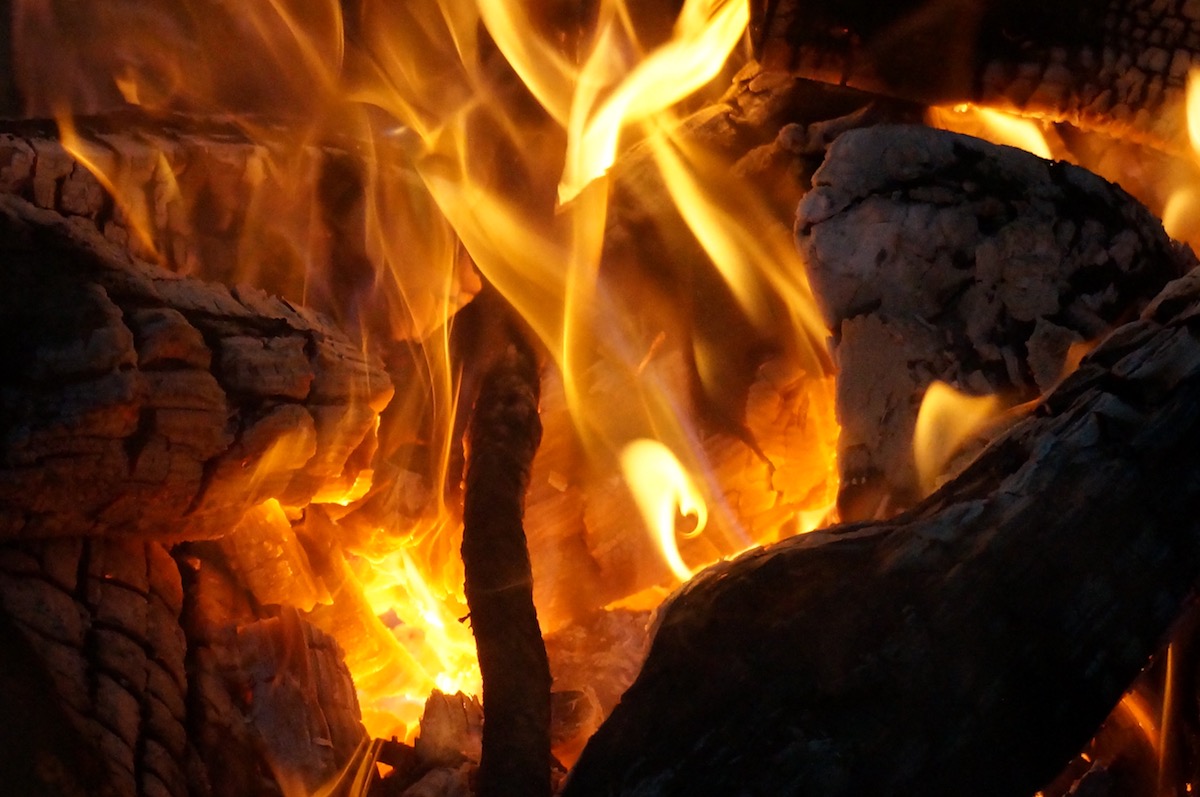Lighting a fire with one match in soaking wet conditions

Because of my difficulties getting a fire going on the last trip, I set myself the goal to go over the basics once more, but in order to challenge myself, I made things “a bit” harder. I was going to make a “one-match-fire” in soaking wet conditions, using only what was naturally available in my back yard.
Last week we had quite some rain, and during the night from Thursday to Friday it poured all night. So on Friday morning I went to our fireplace, armed with a knife and a matchbox, determined to get a fire going using just those and within a reasonable amount of time.
During the “exercise” it did not actually rain, but the canopy overhead was laden with droplets, so every gust of wind meant that whatever was underneath would be showered. Thus rain was adequately mimicked…….
I started looking for dead standing wood. But there was none available, neither were spruce or pine. That made it even more interesting. The first thing I did was take some birch bark and stuck it in the pocket of my pants, so it could dry while I was busy. I also found some rönnbär-bark, or rowan/mountain ash. It had fallen off the tree and looked promising. So that followed the birch bark into the pocket.
The firewood I gathered were dead branches from birch, rowan and Juniper, since that was all there was. On the birch branches, a thick layer of moss had formed, soaking wet and spongy. It actually was a sponge, because when I squeezed the branch, water would pour out of the moss.

I started preparing the wood by first stripping off all the bark and moss. Then I cut off all the darker colored, wet wood until I reached the dry and light colored wood.
I split some branches into ever smaller strips until I had a supply of all sizes. I used all 3 wood types for this. I also made shavings and some small feather stick like contraptions….
I noticed that Rowan wood tends to soak up water even under the bark, so that makes it not very desirable for this type of fire. The drier pieces did burn remarkably well, though.

The wood in various states of preparation

When shaving of the Juniper bark the wood formed small curls which easily took a flame, even when moist

The darker areas of Rowan are wet, even underneath the bark.
I started building a small pagoda fire, after clearing away the wet debris. I filled it with the shavings.

And used one match…

Carefully adding bits of dry and prepared wood, slowly increasing their size. I did keep about half of the prepared shavings and kindling, just as a precaution for when the fire was about to die out… Good thing I did.
Learned about that a few previous times… By keeping the pagoda structure, I was able to dry out the larger wood, before they were actually added to the fire and steadily growing bed of coals.

After a decent bed of coals had been established I wanted to see how well the fire would work, so I added a pile of even the wettest stuff on top. By this time there was enough heat to dry out that and to light it as well….. Mission accomplished!!


While I was sitting there, feeling smug about having achieved this, I witnessed a small spider with a cluster of eggs attached to its abdomen, walk right up to the fire. I was thinking “Stop there buddy. You’ll burn up!”, when all of a sudden it stopped, turned and lifted the egg cluster up. It was warming them in a place so warm, I couldn’t even hold my hand there!!
Amazing!!

p.s.
I never did use the bark to light the fire. Didn’t have to. All in all it took me a bit over 45 minutes from start to a decent fire. Not bad at all….
Many thanks to RonW and Bushcraft UK for supplying this article.
If you liked this article let us know on our Outdoor Revival FaceBook page by leaving a comment.
If you are a keen outdoors person and enjoy making things or developing your camping skills we’re always on the lookout for new content, if you would like to submit to us then please get in contact via our FB page, we’d love to hear from you and we’re always looking for good quality articles.
